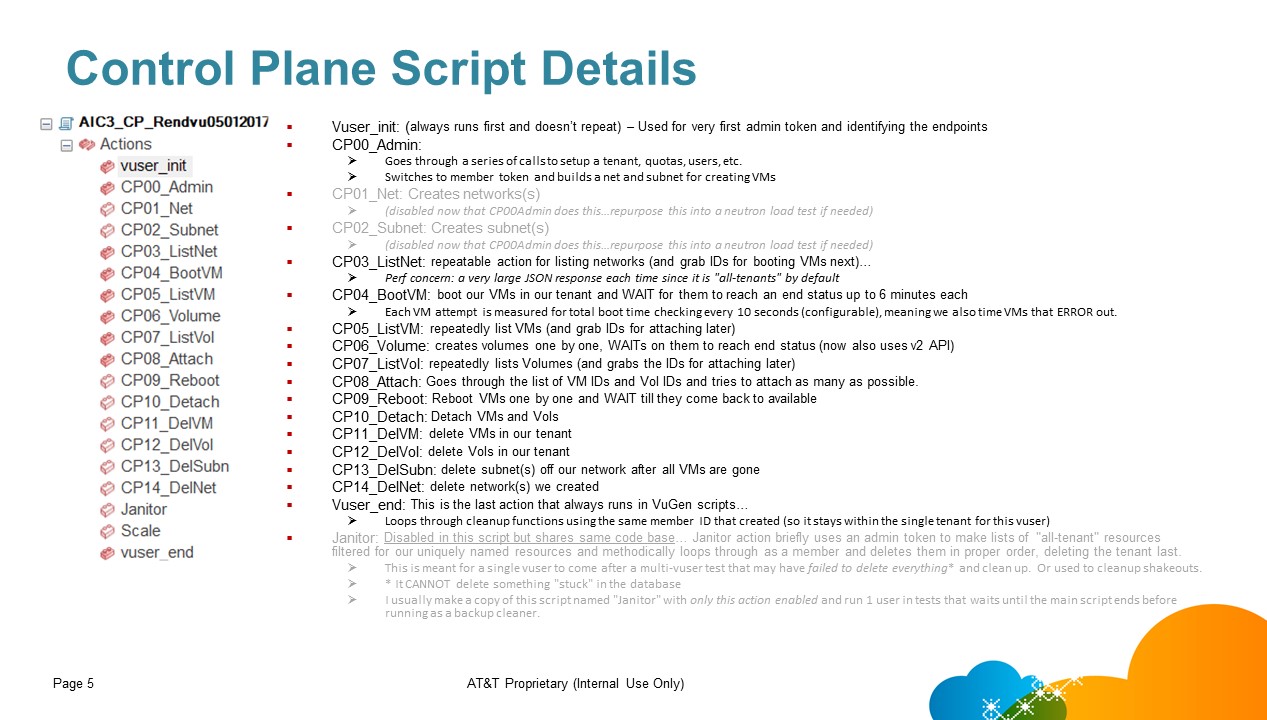...
DelSubn: Delete subnet
DelNet: Delete network
There are also some heat templates used. But this is pretty much what happens for most things.
...
- Orchestration
- Ansible – create rally, shaker, os-faults and metrics gathering plugins
- Test Manager
- Resiliency Studio/Jenkins (AT&T Proposed – time to open source is Aug – Sept 2018)
- Start orchestrator runs
- Collect metrics
- Incorporate capability for SLA plugins
- SLA plugins will decide whether test is a success/failure
- Interact with GitHub/CI-CD environments
- Provide detailed logs and metrics for data
- Create bugs
- Orchestration
- Developer Tools
- Goal:
- Push what can be possible as far left into the development cycle
- Minimize resource utilization (financial & computational)
- Data Center Emulator
- Emulate reference architectures
- Run performance and failure injection scenarios
- Mathematically extrapolate for acceptable limits
- Goal:
- Define test scope & scenarios
- KPI/SLA
- What metrics are part of the KPI matrix
- Examples: Control Plane – API response time, Success Rate, RabbitMQ connection distribution, CPU/Memory utilization, I/O rate, etc.
- Examples: Data Plane – throughput, vrouter failure characteristics, storage failure characteristics, memory congestion, scheduling latency, etc.
- What are the various bounds?
- Examples: Control Plane - RabbitMQ connection distribution should be uniform within a certain std. deviation, API response times are lognormal distributed and not acceptable past 90 percentile, etc.
- Realistic Workload Models for control & data plane
- Realistic KPI models from operators
- Realistic outage scenarios
- What metrics are part of the KPI matrix
- Automated Test Case Generation
- Are there design & deployment templates that can be supplied so that an initial suite of scenarios is automatically generated?
- Top-Down assessment methodology to generate the scenarios – shouldn't burden developers with "paperwork".
- Performance
- Control Plane
- Data Plane
- Destructive
- Failure injection
- Scale
- Scale resources (cinder volumes, subnets, VMs, etc.)
- Concurrency
- Multiple requests on the same resource
- Operational Readiness
- What are we looking for here – just a shakeout to ensure a site is ready for operation? May be a subset of performance & resiliency tests?
- KPI/SLA
- Define reference architectures
- What are the reference architectures?
- H/W variety – where is it located?
- Deployment toolset for creating repeatable experiments – there is ENoS for container based deployments, what about other types?
- Deployment, Monitoring & Alerting templates
- Implementation Priorities
- Tackle Control Plane & Software Faults (rally + os-faults)
- Most code already there – need more plugins
- os-faults: More fault injection scenarios (degradations, core dumps, etc.)
- Rally: Randomized triggers, SLA extensions (e.g. t-test with p-values)
- Metrics gathering plugin
- Shaker enhancements (rally + shaker + os-faults)
- os-faults hooks mechanisms
- Storage, CPU/Memory (also cases with sr-iov, dpdk, etc.)
- os-faults for data plane software failures (cinder driver, vrouter, kernel stalls, etc.)
- Develop SLA measurement hooks
- os-faults underlay enhancements & data center emulator
- os-faults: Underlay crash & degradation code
- Data center emulator with ENoS to model underlay & software
- Traffic models & KPI measurement
- Realistic traffic models (CP + DP) and software to emulate the models
- Real KPI and scaled KPI to measure in virtual environments
- Tackle Control Plane & Software Faults (rally + os-faults)
...
